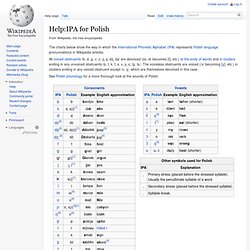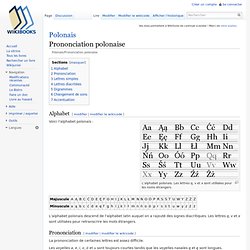

LING550 - Milestone 2. P.lub.lu.se/luur/download?func=downloadFile&recordOId=1321802&fileOId=1321803.
Phonological error mapping: an English – Polish contrastive study. TOPIC 4: Contrasting Polish and English Phonetics. Contrasting selected aspects of Polish and English Phonetics 1.

Consonants 1.1. English The set of English consonants is traditionally considered to comprise 24 consonants, i.e. 1.2. YET ANOTHER LOOK AT INTERLANGUAGE PHONOLOGY: THE MODIFICATION OF ENGLISH SYLLABLE STRUCTURE BY NATIVE SPEAKERS OF POLISH - Hodne - 2006 - Language Learning. McGuire. The Phonology of Polish (Phonology of the World's Languages (Hardcover)) by Edmund Gussmann. This book is the most complete phonology of contemporary Polish ever published.

It is topic-oriented and presents the fundamental characteristics and problems associated with each topic, among them syllable structure, vowel-zero alternations, palatalizations, and other vowel and consonant changes. Professor Gussmann re-examines assumptions about phonological contrasts and alternations, and raises and addresses central questions in morphophonology. He takes morphophonology to be systematically separate from phonology.
Palatalizations, he shows, are crucial to Polish, as both phonological and morphophonological phenomena: their detailed description leads him to a systematic presentation of vocalic alternations. The book develops a Government Phonology account of Polish, but is primarily a description of the language with the model subordinated to the organization of data. ZygisHamann2003. Polish Phonology - UniLang Wiki. IPA for Polish. The charts below show the way in which the International Phonetic Alphabet (IPA) represents Polish language pronunciations in Wikipedia articles.

See Polish phonology for a more thorough look at the sounds of Polish. See also[edit] External links[edit] Polish Pronunciation Audio and Grammar Charts Further reading[edit] Sadowska, Iwona (2012). Notes[edit] ^ Jump up to: a b c d e f g h i j The letter ‹i›, when followed by a vowel, either represents a pronunciation like a ‹j› or a "soft" pronunciation of the preceding consonant (so pies is pronounced as if it were spelt ‹pjes›). International words in Polish - Audio Files by Polish Native Speakers. Polish Pronunciation Guide Unit 1. Polonais/Prononciation polonaise. Un livre de Wikilivres.

Alphabet[modifier | modifier le wikicode] L’alphabet polonais. Les lettres q, v et x sont utilisées pour les noms étrangers. Voici l'alphabet polonais : L'alphabet polonais descend de l'alphabet latin auquel on a rajouté des signes diacritiques. Prononciation[modifier | modifier le wikicode] La prononciation de certaines lettres est assez difficile. Les voyelles a, e, i, o, ó et u sont toujours courtes tandis que les voyelles nasales ą et ę sont longues. Écoutez l'alphabet lu en polonais : Lettres simples[modifier | modifier le wikicode] Polish phonology. The phonological system of the Polish language is similar in many ways to those of other Slavic languages, although there are some characteristic features found in only a few other languages of the family, such as contrasting retroflex and palatal fricatives and affricates, and nasal vowels.

The vowel system is relatively simple, with just six oral monophthongs and two nasals, while the consonant system is more complex. Vowels[edit] The vowel system[edit] The Polish vowel system consists of six oral and two nasal vowels. Vowel nasality in Polish is preserved from Proto-Slavic, having been lost in most other modern Slavic languages. All the oral vowels are monophthongs. The nasal vowels do not feature uniform nasality over their duration. Abstract. A Polish Grammar. Part two Back to the first page The phonetics of the Polish language, part 1 The Polish language contains both affricates like “dz” and combinations of sounds which we may interpret as two separate phonemes, for instance “d+z”.

The IPA standard, usually used for phonetic transcription (but not by Slavists), does not provide any separate single symbols for the affricates, treating them like combinations of two sounds. Moreover the same symbol is in use for the Polish “sz” as for the English “sh” in spite of their evidently different pronunciation. Even if Polish spelling does not always give sure instructions for pronunciation, the rule “read like it is written” can be observed to a much greater extent than in English. However, it is comforting for Poles when you compare all that with the English language, where it can seem that no rules of pronunciation and spelling are obeyed. But let’s go back to the Polish pronunciation. All other palatalized consonants may occur only before a vowel. Polish o-Raising and Phonological Explanation download PDF file - /download/15_keyword-phonology-polish-english/polish-o-raising-and-phonological-explanation.pdf.
IPA_ifc. Tipaman. Www.tug.org/TUGboat/tb17-2/tb51rei.